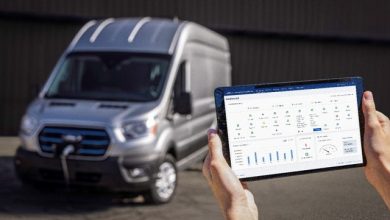HERE – SBD Automotive EV Index for US & Europe
Berlin and Detroit – To mark World EV Day on September 9. HERE Technologies, in conjunction with SBD Automotive, published an interactive index. This index shows the developing state of electric vehicle (EV) demand and infrastructure readiness across the United States and Europe.
The HERE-SBD Automotive EV Index highlights U.S. state-level and European country-level leaders and laggards based on various critical metrics since 2020. These metrics include the number of charging points (Electric Vehicle Supply Equipment), vehicle registrations, geography, and road network length.
The Index is based on the following metrics, each ranked out of a maximum score of 25 for a total score out of 100:
- How far you must drive to find a charger – number of public Elecric Vehicle chargers per road length.
- How quickly you can charge – the average power capacity of public EV chargers.
- The number of EVs on the road versus internal combustion engine vehicles – EV fleet share.
- Likelihood of finding an unoccupied charger – the ratio of registered EVs to public chargers.
Highlights of the HERE – SBD Automotive EV Index
Every state and country has its own unique circumstances around electric vehicle adoption and charging infrastructure. In more nascent markets, such as many U.S. states, it is important to use the number of registered EVs-per-charger ratio. In more mature markets, a “power-per-EV” ratio can be more useful.
For example, California, with its large population and geographic size, had almost a million registered electric vehicles by 2022. California also boasts one of the most developed electric vehicle charging networks in the U.S. with more than 46,000 chargers. However, California ranks among the bottom 10 states in terms of EVs per charger with a ratio of nearly 20:1.
Eight to twelve electric vehicles per public charging point tends to be the ideal ratio for the average market to support seamless, convenient public charging, according to analysis from SBD Automotive. As the market matures, this ratio should increase as geographic coverage becomes less critical. This also prevents over-supply enabling charge point operators to turn a profit, sustaining its industry.
United States
The top overall states in the HERE – SBD Automotive EV Index
(1) Washington, D.C. (2) Connecticut (3) Vermont (4) Massachusetts (5) Maryland (6) Maine (7) New York (8) Colorado (9) Rhode Island (10) California
The bottom overall states in the HERE – SBD Automotive EV Index
(42) Wisconsin (43) Indiana (44) Louisiana (45) Kentucky (46) Texas (47) Nebraska (48) Tennessee (49) Idaho (50) Arkansas (51) Alaska
Europe
The top overall countries in the HERE – SBD Automotive EV Index
(1) Norway (2) Netherlands (3) Luxembourg (4) Germany (5) Switzerland (6) Denmark (7) Czech Republic (8) Bulgaria (9) Sweden (10) Belgium
The bottom overall countries in the HERE – SBD Automotive EV Index
(21) Italy (22) United Kingdom (23) Hungary (24) Romania (25) Ireland (26) Poland (27) Lithuania (28) Greece (29) Malta (30) Cyprus
The full rankings, interactive visuals and maps for all 50 U.S. states and 30 EU countries can be found at: https://www.here.com/ev-index
“While the maturity of charging infrastructure in each state and country generally follows population density and wealth, the index clearly demonstrates that external factors such as government incentives help equip lower-density areas with much-needed charging capacity,” said Robert Fisher, EV Principal at SBD Automotive. “Charge point operators and regulators must monitor the ratio of EVs to charging stations and power availability. They should also consider the size of the electric vehicle fleet in communities and along corridors. This ensures a seamless ownership experience as EVs become mainstream, while protecting infrastructure operating revenue.”
“Electric vehicles are top of mind for consumers, governments and the auto industry all over the world. Stemming from the development of our EV Charge Point Predictions product, HERE and SBD have uncovered a growing discrepancy. This discrepancy is in the ratio of EV charge points to EV vehicles on the road,” said Chris Handley, Vice President of Dynamic Spatial Content at HERE Technologies. “Our analysis shows how much work needs to be done in order to usher in a fully electric mobility future.”
Key Findings:
U.S.
- With an EV market share in 2022 of just over 7%, the U.S. as a whole should ideally have eight to nine EVs per public charger, with each state having its own ideal ratio based on several market maturity metrics.
- As the market-leading state in the U.S., California’s ideal ratio would be close to twelve EVs per charger. On the other hand, North Dakota, with a large land area and very small EV fleet size, would need to aim for closer to two EVs per charger.
- One of the most important goals of the National Electric Vehicle Infrastructure (NEVI) program is to equip all regions to support inter-state travel and commerce. Even though less densely populated states will struggle to achieve the same ratio of public chargers to EVs. Major travel corridors will continue to be equipped with additional public charging infrastructure in the coming years through NEVI program funding. This will ideally enable seamless electric mobility nationwide.
EU
- Europe is a great example of how each country approaches charging infrastructure in a different way. It exists at a different point in time in the maturity of its EV market.
- The Netherlands is one of the most mature EV markets in Europe, having more than a decade of strong government support. This led to a proliferation of AC charging since DC charging had not yet been standardized. Meanwhile, Malta has very few DC chargers because, as a small island country, charging would rarely be necessary.
- A key feature of the European Commission’s infrastructure targets (AFIR) focuses on travel between EU countries, meaning that important travel and commerce corridors through countries with a low EV market penetration like Bulgaria will have a high density of chargers relative to registered EVs.



